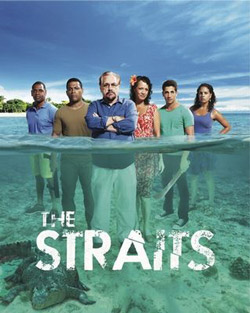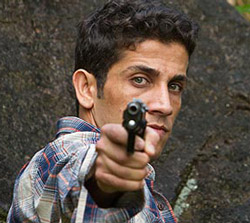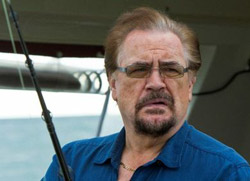 Things we think about when we think of Australia: kangaroos, the Sydney Opera House, endless beaches, tropical reefs, Paul Hogan, Anna Torv (or Elle Macpherson, if you’re of a certain age).
Things we think about when we think of Australia: kangaroos, the Sydney Opera House, endless beaches, tropical reefs, Paul Hogan, Anna Torv (or Elle Macpherson, if you’re of a certain age).
Things we don’t think about when we think of Australia: meth smuggling, organized crime, biker gangs, human trafficking, torture, mob hits.
The Straits is about the things we don’t think about.
Handsomely produced for the Australian Broadcasting Company (ABC) in February through April of 2012, The Straits was at its core a recasting of The Godfather set in Far North Queensland, the tropical upper-right corner of Australia. It’s an interesting mix of American gangster tropes and Aussie social atmosphere that lasted ten episodes before ABC decided to not continue the series. It’s now available on Hulu.
Harry Montebello (veteran heavy Brian Cox) is an Aussie Vito Corleone, patriarch of a sprawling family whose business is all manner of crime. He and his Melanesian wife Kitty (Rena Owen) have, over the years, adopted four now-grown children from Kitty’s native Torres Strait Islands: Noel (Aaron Fa’aoso), the oldest and the Sonny Corleone stand-in; Marou (Jimi Bani), the family’s Michael Corleone; Gary (Firass Dirani), the Fredo analogue; and Sissi (Suzannah Bayes-Morton), by default the Connie Corleone substitute, except with a college degree and an attitude.
Harry’s empire stretches across the Torres Strait, which separates Australia from Papua New Guinea (PNG), and the 274 islands that dot those waters. He ships guns into PNG to trade to the local rebels for meth, which he then sells to the main biker gang (“bikies”) in Cairns (otherwise known as the gateway to the Great Barrier Reef). Various other business opportunities arise from time to time, and business is booming: the Montebello estate is a sweeping mansion in the hills above Cairns, big enough to house all the family and their various hangers-on. Life is good, if you don’t mind having to feed the occasional miscreant to a swarm of toxic jellyfish.
Then Harry decides he wants to retire and leave the business to one of the kids. Problem: he doesn’t think any of them have the grit to run it properly. He sets them against each other in a competition to see who can fill his shoes – and gets way more than he bargained for.
 The parallels I drew between the younger Montebellos and their Godfather peers aren’t coincidental. Noel is a hothead who thinks using a rocket launcher to start a war with the bikies is a good tactical move; his problem is that he never graduates from tactics to strategy. Marou runs the family’s legitimate businesses, is a lay preacher and at best ill-at-ease with the shadier parts of the illegitimate businesses. Gary will drink, snort, smoke or screw anything that crosses his path, which gets in the way of getting any work done right. If it sounds like a sorry bunch, well, that’s Harry’s opinion, too, and as things get messier and spin further out of control, you’ll wonder whether any of the three ought to be in this line of work.
The parallels I drew between the younger Montebellos and their Godfather peers aren’t coincidental. Noel is a hothead who thinks using a rocket launcher to start a war with the bikies is a good tactical move; his problem is that he never graduates from tactics to strategy. Marou runs the family’s legitimate businesses, is a lay preacher and at best ill-at-ease with the shadier parts of the illegitimate businesses. Gary will drink, snort, smoke or screw anything that crosses his path, which gets in the way of getting any work done right. If it sounds like a sorry bunch, well, that’s Harry’s opinion, too, and as things get messier and spin further out of control, you’ll wonder whether any of the three ought to be in this line of work.
As it turns out, the women in the family are a more dynamic and on-the-ball bunch than the sons. Kitty is the requisite Lady Macbeth figure, pulling strings, ordering people’s lives back home in the Torres Strait, soothing ruffled feathers or ruffling them when needed. She’s the Aussie grande dame back home in Cairns, then slips effortlessly into the Brokan-speaking (a kind of PNG-Torres Strait pidgin) tropical queen persona on the islands. Sissi really doesn’t want anything to do with Harry’s or her brothers’ dirty doings, but Dad ropes her into learning how to keep the (multiple sets of) books; this leads her to morph into the Connie Corleone of Godfather III, slowly taking control behind the scenes. Marou’s pretty young wife Lola (Emma Lung) wants very much for her unwilling husband to take over from Harry and is quite happy to use her physical assets to make that happen.
 So far, so Sopranos. Although The Straits was made for broadcast TV, its vibe is more premium cable; George Carlin’s seven words are used regularly, the killings and beatings are brutal and bloody, and Lola gets naked on a regular basis (not always with her dear hubby). At the same time, it’s an exercise in cognitive dissonance to see all the familiar gangster-type fun and games taking place against a backdrop of rain forests, incredibly blue water and endless sunshine.
So far, so Sopranos. Although The Straits was made for broadcast TV, its vibe is more premium cable; George Carlin’s seven words are used regularly, the killings and beatings are brutal and bloody, and Lola gets naked on a regular basis (not always with her dear hubby). At the same time, it’s an exercise in cognitive dissonance to see all the familiar gangster-type fun and games taking place against a backdrop of rain forests, incredibly blue water and endless sunshine.
As an American viewer, I noticed things that might not make a dent on an Aussie audience. The Montebellos are a thoroughly mixed-race family, Noel and Marou are married to very white young women, yet nobody remarks on this on-screen. This would become some kind of plot issue on an American show. Also, you can tell this series wasn’t made in Hollywood because most of the characters aren’t notably physically attractive; Harry looks like he’s been hit with a shovel, Kitty is a sixty-something matron, Noel and Marou are built like cinder blocks, Sissi would be considered “plus-sized” on American TV and Gary, the supposedly good-looking one, is more Michael Imperioli than George Clooney. It lends an unexpected air of reality to the otherwise wild goings-on.
If you like mafia sagas and need a break from your Sopranos DVDs, check out The Straits. The entire series is on the free side of Hulu, which ably continues its mission to bring us obscure English-language TV shows from around the world. The show will seem entirely familiar and yet indescribably foreign – almost like a vacation in Australia.
Lance Charnes fondly remembers his dive trip to Queensland, during which he watched no Aussie TV. Australia is not one of the three continents on which his 2012 debut international thriller Doha 12 (now available on Amazon and at Barnes & Noble) is set. He tweets (@lcharnes) about scuba diving, shipwrecks and marine archaeology.
